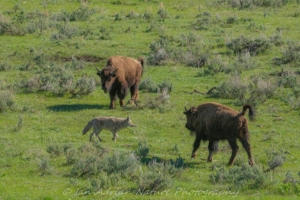
Coyotes are incredible creatures. Like wolves, they form tightly-knit family groups or “packs,” sometimes hunting cooperatively to take down larger or more difficult prey. They eat a wide variety of food items, from rabbit (which seem to be the favored entre), to reptiles, birds, eggs, plants, berries and, when they’re desperate, even the occasional roadkill steak. Highly adaptable, coyotes can be found in rugged mountains, grassy plains, swamps, coastlines, and even North America’s largest cities (NYC has a thriving population). Their vast range extends from Northern Canada’s boreal forests, to as far south as the Panama Canal.
Still widely persecuted in the Eastern US, using models based on highly-questionable ethics, the coyote seems to hold much more esteem in the Southwest. I would even go as far as to say that it’s something of an icon in this part of the country. Although coyotes still lack well-deserved legal protection, many Southwesterners appear to see them as another feature of this unique desert habitat. Keep pets under supervision, and coyotes pose little threat to our day-to-day lives. Not only do they pose little threat, but the city dwelling ones have actually made a significant dent in populations of such disease-carrying rodents as the Norwegian Rat (the species which has infested every city across the globe).
Perhaps the most incredible thing about coyotes is their history. Unlike many large mammals, which prehistorically crossed between Russian and Alaska via the Bering Straight, and resulting in a number of nearly world-wide subspecies, the coyote (unlike it’s cousin, the gray wolf, which spread across Europe and Asia) remained right where it started. Also, quite interestingly, while such alpha predators as the mountain lion, wolf, and grizzly bear suffered extensively at the hands of increasingly temperamental humans, the coyote only prospered. The extirpation of larger, more aggressive predators allowed coyotes to thrive with reduced threat and competition. When humans had all but eradicated these other predators, they turned their attention to the less-threatening coyote. As a result of it’s remarkable adaptability, many years of aggressive government-backed initiatives to exterminate the coyote (by any means necessary) resulted in a fortune of wasted taxpayer money, and no “progress,” whatsoever.
When my Arizona move was just in the planning phase, I eagerly anticipated the chance to see more of these intelligent canines throughout day-to-day life, as they are much tougher to encounter in small-town PA. I had seen, heard (and on one occasion, even caught one curiously watching me photograph a scorpion, from a few feet away) on previous Southwestern trips, but never had the faintest clue just how prevalent they were. Only 2 weeks into my Tucson-outskirts residency, and I’ve already had nearly 10 sightings, many of which on the dirt roads near my home, but early-morning hikes have also yielded encounters. With every sighting, I’m helplessly reminded of the majestic and intuitive “White Fang,” from one of my favorite childhood movies (despite the obvious inconsistencies in of this association).
Nearly every morning and evening, as I’m greeted by the eerily-beautiful call of the aptly-nicknamed “song dog,” I excitedly pre-meditate the next concurrence. I can’t imagine this incredible place without them.

Facebook Comments